The best way to implement an effective pricing strategy for your products is to investigate the market and the competition carrying out ab ecommerce price monitoring strategy. Generally, when comparing products, the same item reference code is used and the price set for those products is compared. So far easy, isn’t it? But in some cases you may be tracking products that are identical, but that come in different packages and that may affect the quantity that comes within the package or the units that come for each package, so you cannot compare the product types with the same standard. In these cases the most convenient action is to use mathematics solutions or formulas that will allow you to compare products on conditions of equality.
In this guide we will give you the required skills to get the most out of your goods, as well as to be able to develop an ecommerce price monitoring strategy, taking into consideration those products from the competition that may be sold in packs of different units.
How to implement an ecommerce price monitoring for products that are sold using different formats?
Having to keep track of products with different packages or that are sold using different formats can be quite a headache as the price comparison process is not automatic, having to account for the unit price or the price of the product by weight.
The industries and verticals in which it is most common to find these format difference situations are:
- Grocery
- Sport Nutrition
- Health and Personal Care
- Pet food, etc.
- Medical Devices
- Office Supplies
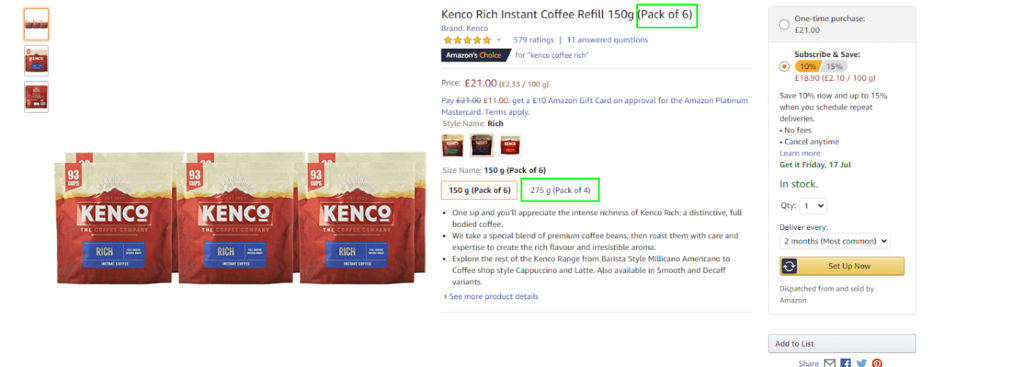
This sort of differentiation in packages can make it quite difficult to compare products on a basis of equality. This is: For instance: I cannot compare a package of 1 kg of pet food against the very same product but in a package of 2kg. If we did so, we would get a wrong and inaccurate competitive analysis and that would affect the way my store reacts to the pricing changes of competitors in the market.
As a retailer in a competitive industry, you need to be as accurate as possible when gathering information and elaborating actions based on them.
How to compare identical products that come in different unit packs
The best solution for this common problem can be summarized in one word: ‘formulas’. What are those formulas? Basically, formulas are just a mathematical way of getting to the price of what a unit or a set of units would cost. Why is this useful? Let’s look at an example of this situation in the Pet Food industry, where we are able to clearly see why this is useful:
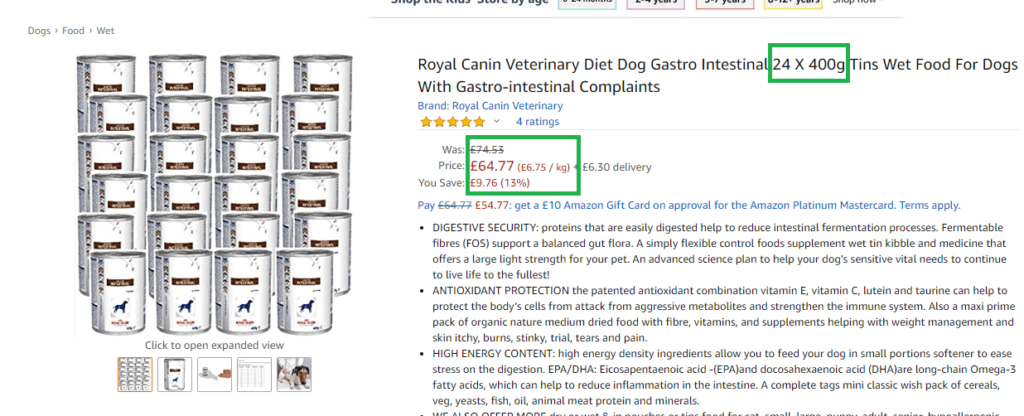
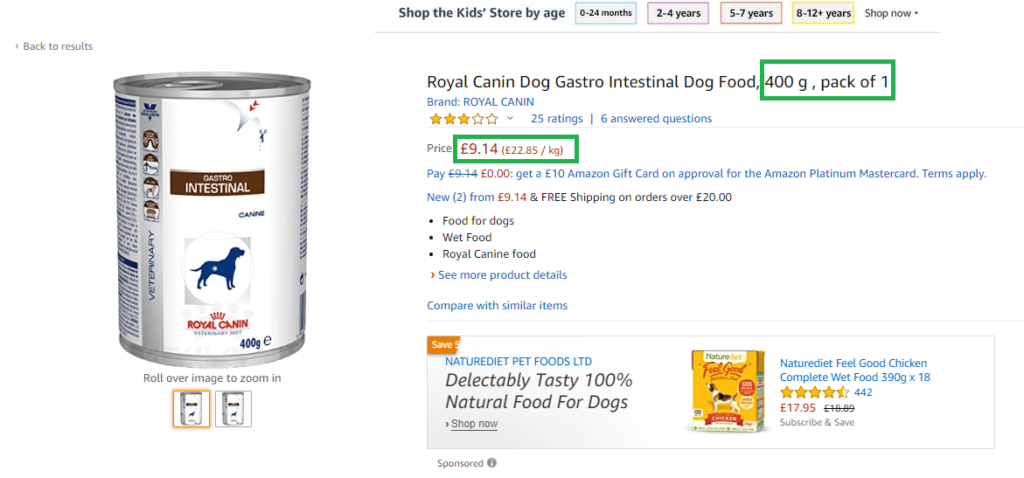
So basically, here we can see the same product within the Pet Supplies category. But in one of the cases what we can see is a pack of 1 (a single product) and then in the other case we have the same product with the same format (400 g) but this product comes in a pack of 24 units.
Let’s imagine that one of your direct competitors is selling this product in the pack of 24 format, while in your store you are selling it by single units. How would you benchmark your pricing against your competitor if you are really not competing on the same conditions?
This is when formulas come into action. Let’s have a look at how we would do it:
So again, we have this product: ‘Royal Canin Wet Food Gastro Intestinal Canine 400 GR’ and in the case of our shop we sell it in a pack of 1. So this is how it would look like:
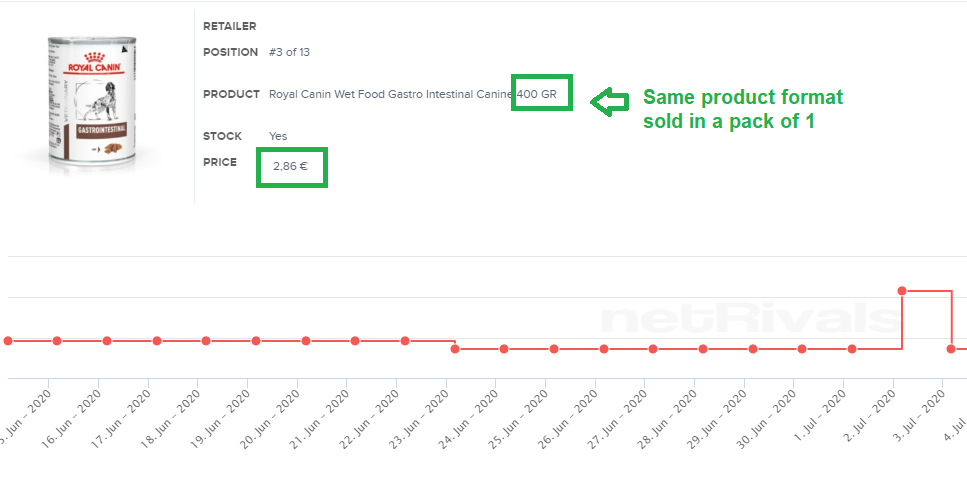
Ecommerce price monitoring via Netrivals’ Cross-module viewer
Nevertheless, one of our competitors sells the very same product but in a pack of 12.
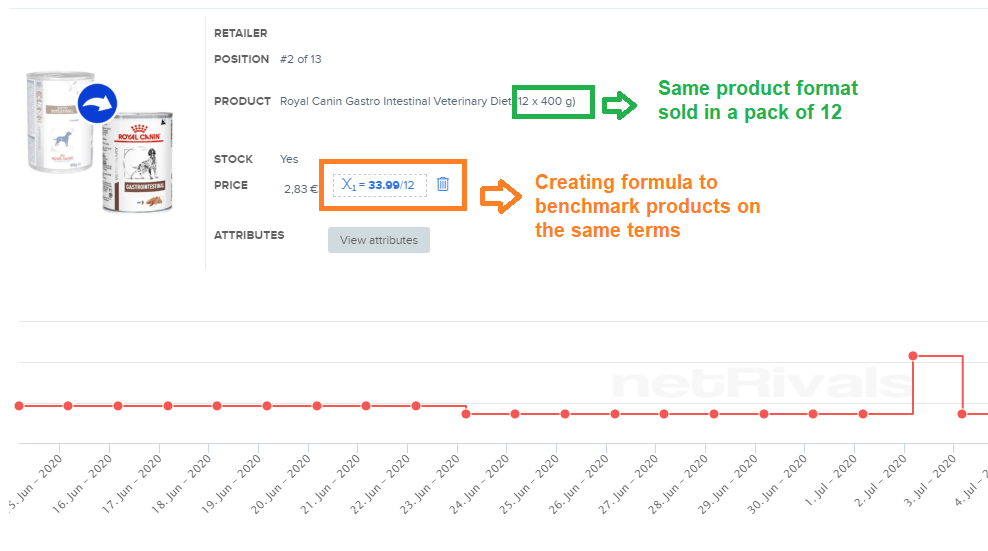
Benchmarking products via Netrivals’ Cross-module viewer
You cannot simply compare these two products as if they were the same thing. We are not comparing products on the same terms, that is why it is so important to be as accurate as possible to obtain reliable results in our competitive analysis.

By doing this, you are able to include more competitors in your rival equation and your market analysis does not get corrupted by figures which would distort the results on the competitive status of your store.
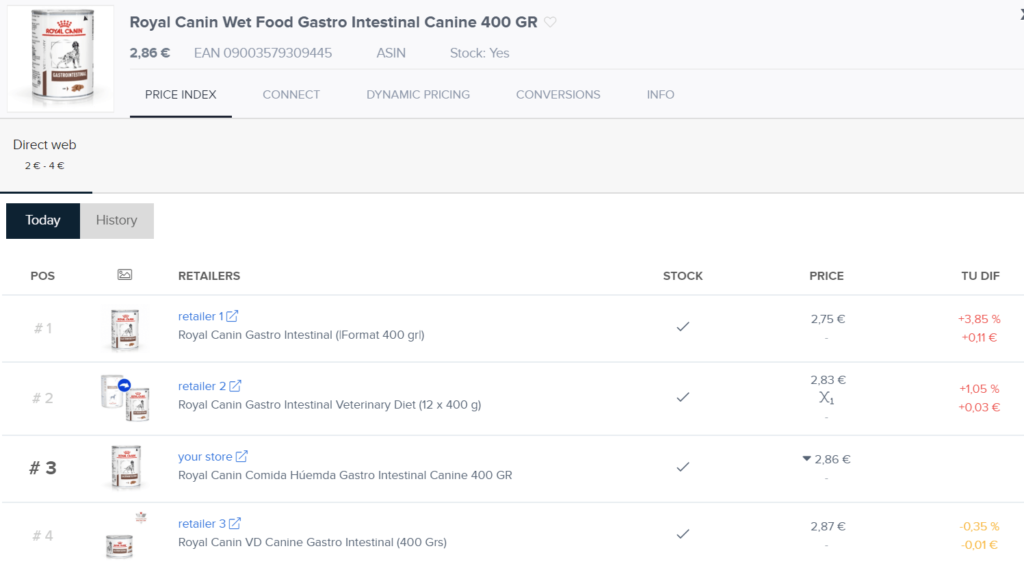
Analyzing your competitive status and position based on products sold in different unit packs via Netrivals’ Cross-module viewer.
How to assess how you compete against other competitors in the market
Thus, through ecommerce price monitoring of products, you can compare products under the same conditions. You can assess what your true competitive situation is for those products in the market.
You have different methods to evaluate your position in the market, the most used are:
- Evaluate according to the competitors in the market: it can be used to analyze your position in relation to that of your direct rivals.
- Evaluate your competitive status on a global scale: it allows you to analyze how efficient your store is as a whole and compare it with your most relevant competitors.
- Assessing competitive status on specific products: this procedure is convenient to use when you want to maintain a differentiated strategy for a specific type of product, for example, when you want to pay special attention to a new product in the market.
How to price your products to get more conversions for your business
Once you are clear about the unit prices of your competitors’ products, it is time to improve the pricing strategy for your catalog. Using Dynamic Pricing tools means that you can be more competitive and identify opportunities to increase your profit margins in advantageous situations for your e-commerce- if you are the only store in your vertical that has stock for a given product-. With these tools you can safeguard your profit margins without risking the conversions of your online store, thanks to the implementation of customizable rules that update the prices of your items in real time.
Final Thoughts about ecommerce price monitoring
In this guide we have provided you with tools to, first, identify when a competitor is selling their products in packages of different units, and second, to implement formulas that allow you to standardize prices at the same level in order to correctly analyze the competitiveness of your products.
It is important to emphasize that implementing these formulas for products sold in packs manually can take a lot of time that could be spent on other aspects of your e-commerce. That´s why we recommend the use of ecommerce price monitoring, to automate the process of product identification and implementation of these formulas to be on track with the competition.




